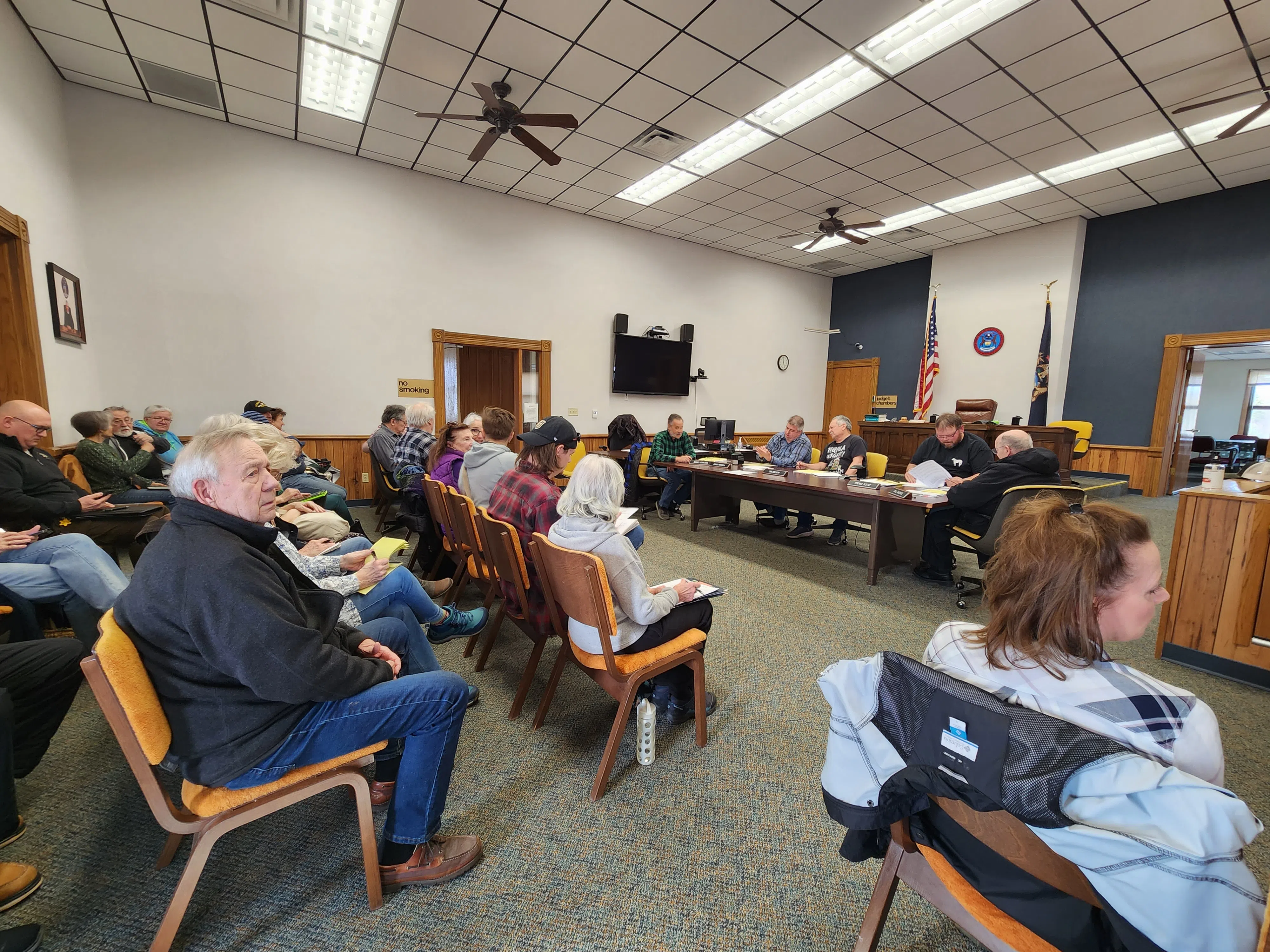
A full room gathered at the Baraga County Commission meeting in March 2025 to express concerns over cuts in the federal workforce and funding.
Baraga County Memorial Hospital has kept up the pace for another good year. Last evening the community hospital’s CEO Rob Stowe provided the Baraga County Memorial Hospital’s annual report to the county board of commissioners. Stowe says in the past year BCMH has seen 21 percent more patients. Some are coming from Ontonagon County. Last spring Aspirus Health closed the Ontonagon hospital that served the community for more than 50 years.
Currently, Ontonagon County residents represent about 15% of our ER volume. They represent 25% of our inpatient volume. And so certainly we welcome that community to our hospital, and they have very clearly chosen BCMH to get their care. In the last call I had with the state, they shared with me that 80% of the emergencies that happened in Ontonagon County are coming to BCMH, and we’re very proud of that. – Rob Stowe, CEO, Baraga County Memorial Hospital
In 2024 Baraga County Memorial Hospital accounted for 31 new jobs in the county. The hospital has added new providers bringing the facility’s total to 21 licensed physicians. Including a new general surgeon added to the region.
Proud to announce that we have secured our very own general surgeon. He’ll be joining BCMH. So that’s a big deal for this hospital. It’s a big deal for the county. We’re very excited about that. He’ll be joining us in the coming months. – Rob Stowe, CEO, Baraga County Memorial Hospital
In action, the Baraga County Commission approved sick leave plans for part-time employees in line with the state’s recently enacted legislation from 2017. Baraga County will front load part-time sick leave and grant 72 hours to employees rather than the accruement plan.
Another action by the commission included supporting a resolution calling for local control to take precedence for zoning decisions, especially related to renewable energy developments such as wind farms. Last year the state’s Michigan Public Service Commission adopted rules in line with state law and renewable energy goals, which aim for 50 percent of energy production in the state from renewable sources by 2030. 72 townships joined a lawsuit in November against the Public Service Commission, contesting the new rules that limit local authorities to too much for the sake of energy goals.
After the commission completed action for the evening, several residents called on local leaders to take up a resolution protecting federal funding for sea lamprey eradication efforts, Medicaid beneficiaries, and veterans affairs programs. Many of the residents in attendance shared recent news of federal cuts by the Department of Government Efficiency and potential impacts in the Upper Peninsula and Great Lakes region. Baraga resident Phil Keyes spoke out for fishermen and fisheries. Starting in the mid-20th century, collaborative efforts by federal and state partners sought to control the spread of sea lamprey in the Great Lakes brought in by sea-fairing cargo ships. Sea Lampry invasion into the Great Lakes was first seen in Lake Ontario in the late 1800’s. By 1938 the invasive species spread to Lake Superior.
The mitigation in the Upper Peninsula for Lake Superior, these groups killed over 8 million lampreys per year. One female lamprey in the course of its 12 to 18 months of living can generate anywhere between 65,000 and 110,000 eggs, which can go out into the Great Lakes. Now recently, 12 employees from the US Fish and Wildlife have been terminated from their positions. – Phil Keyes, Resident
Another resident shared that several employees working in the Hiawatha National Forest were fired in the recent cuts to the United States Forest Service. Outside Magazine reported in late February one Isle Royale employee was let go by the National Park Service in that round of cuts. The park’s staff page, updated on February 13th, 2025, shows a single vacant position for a Botonist.
Isle Royale’s fauna includes species such as Packera insulae-regalis, Calypso orchid, and Thimbleberry. Endangered species residing in the park include Lingonberry or mountain cranberry, and 58 other endangered species. Isle Royale’s botanist would have begun cataloging when and where these species grow on the island starting in the spring when staff arrives on the island. The role is also responsible for developing conservation plans to protect various plant species.
Veteran Ken Haaja shared that the discussion over recent cuts to Veterans Affairs broke out at the Baraga VFW hall.
Thank you for helping out our local veterans. I do not go to the BCMH for my care. I do go to Iron Mountain. I go to the Hancock Clinic. But when you’re talking about cutting 83,000 people to bring them back down to a 2019 level with the PACT Act and all the other things that go on, I laugh when I see people. Share the veteran suicide numbers. Can I get one friend to share this number? And I laugh because if anybody gets cut to that level, nobody’s going to be there to answer the call when I call.- Ken Haaja, Resident
In 2019 the suicide rate of veterans in the United States grew to 27 service members per 100,000.
Former BCMH physician Sharon Gilliand spoke out for nursing home residents, and Medicaid beneficiaries unable to visit the Baraga County Courthouse for the commission meeting. BCMH CEO Rob Stowe shared with the room that 15 percent of patients at the hospital receive Medicaid benefits.
My father was at Bayside Village, and after we spent down all of his assets, Medicaid was really important for end-of-life care. So I think that the federal cuts are going to affect all of us, but I think we need to stand up particularly to protect Medicaid. I am a Medicare recipient. I heard recently the president doesn’t want to touch Medicare because he knows those of us who get Medicare are going to stand up and fight. People who get Medicaid may not be able to. – Sharon Gilliand, Resident
President Donald Trump won Baraga County’s vote by 1,290 votes in 2024, receiving 39 percent of the eligible voter total. Baraga County has 6,951 eligible voters in the region. 4,353 voters participated in the November general election. Voter participation in Baraga County was slightly below the national average, just under 64 percent, in November with about 62 percent of voters casting ballots.







Comments